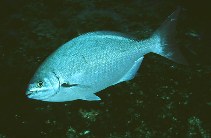| Family: |
Kyphosidae (Sea chubs) |
| Max. size: |
76 cm TL (male/unsexed); max.weight: 6,010.0 g |
| Environment: |
reef-associated; marine; depth range 1 - 30 m |
| Distribution: |
Circumglobal. |
| Diagnosis: |
Dorsal spines (total): 11-11; Dorsal soft rays (total): 11-12; Anal spines: 3-3; Anal soft rays: 11-11. Gray overall, with faint yellow lines on side and yellow line from corner of mouth to preopercle (Ref. 26938). Upper part pf opercular membrane blackish. The young may display pale spots nearly as large as eye on the head, body and fins (Ref. 13442). Each jaw with a regular row of close-set, strong, incisor-like, round-tipped teeth of a peculiar hockey stick-shape, their bases set horizontally, resembling a radially striated bony plate inside mouth (Ref 52729). |
| Biology: |
Inhabits shallow waters, over turtle grass, sand or rocky bottom and around coral reefs (Ref. 3725). Young commonly found among floating Sargassum seaweeds (Ref. 3725). Feeds on plants, mainly on benthic algae, as well as on small crabs and mollusks (Ref. 6547, 44187). Also feeds on spinner dolphins’ feces and vomits at Fernando de Noronha Archipelago, southeast Atlantic. The offal feeding may be regarded as a simple behavioral shift from plankton feeding to drifting offal picking (Ref. 48727). Marketed fresh (Ref. 3725). |
| IUCN Red List Status: |
Least Concern (LC); Date assessed: 24 August 2012 Ref. (130435)
|
| Threat to humans: |
harmless |
Source and more info: www.fishbase.org. For personal, classroom, and other internal use only. Not for publication.
